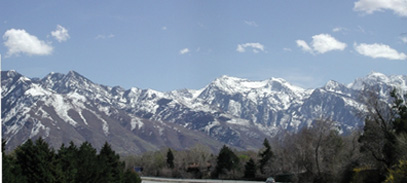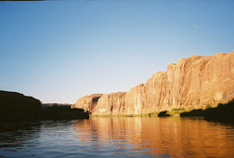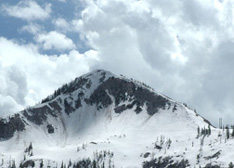Global Warming and Climate Change: Is the Quantity of Utah’s Water Resources at Risk?
Water Users hear about a threat to Utah’s water resources and the need to plan for climate changes in the West.
LeRoy W. Hooton, Jr.
December 7, 2007
|
The water profession is becoming more engaged in learning more about global warming. All of the major professional organizations have become actively involved in the subject. There are differing opinions regarding global warming and greenhouse gas emissions; however, there appears to be overwhelming consensus that more study, data collection and modeling are necessary to fully understand the consequences of global warming and its effect on the nation’s water resources.
“There is no longer any scientific doubt that the earth’s average surface temperature has risen 1.3 degrees F during the past century and warming has accelerated during the past decade,” said director of the Utah Climate Center – State Climateologist Dr. Rob Gillies, adding “It’s more likely than not that water supplies in Utah and the Colorado River Basin will decline in the 21st century.” Last year was the second warmest summer recorded in the continental U.S. since recordkeeping began in 1895, and according to NOAA, eight of the past 10 years have been above-average temperatures. According to Dr. Gillies, during the last decade Utah was 2 degrees warmer than the 100 year average.
According to 75 percent of 25 models, global warming will have an adverse effect to the rapidely growing southwestern U.S., making this region and Utah more arid.
There are models that indicate that northern Utah is in the transition zone and could be either wetter or drier; but according to Dr. Gillies there is strong evidence that Utah could become drier. He points to the Hadley Cell model, which predicts the sub-tropics zone expanding northward with intrinsic high pressure cells dominating the weather patterns of the West, forcing the jet stream to steer storms north of Utah. This will result in the state becoming drier. “The (Hadley Cell) processes are very well understood,” said Dr, Gillies, “… and factoring in warmer temperatures in the summer the whole state will see drying conditions.”
|
The Colorado River Basin is currently in an 8 year drought. From 2000 to 2007 the basin has experienced the driest period during 100 years of historic record. The year 2002 was the second driest water year of record. The drought has reduced the storage volume in Lake Powell to 53 percent full and Lake Mead to 48 percent full in 2007.
Eighteen of 24 models show a decrease in snowmelt run-off because snowpack will be reduced by more rain events; less snowpack at lower elevations; more soil and water evaporation and earlier snowmelt in the spring months; and later snowpack building in the fall months. Even if precipitation is not changed with warmer weather, the water supply from mountain watersheds will change from the historic hydrological cycle. The water captured in mountain snowpack and stored in reservoirs during the historic spring run-off will be both less than normal and out of sync with water demand of agriculture and municipal users.
Other detrimental effects caused by drier climate conditions included deterioration of water quality; forest and rangeland invasive pests and weeds proliferation; and increased forest and rangeland wildfires.
“Human impacts are affecting global temperatures,” stated Utah Division of Water Resources director Dennis Strong. He said with the projected state population growth water conservation will be necessary to help meet future water demand, but this saved water will not protect the state water users from droughts. “We still need to build dams and store water,” he said.
Weber Basin Water Conservancy District manager Tage Flint said that water managers should no longer debate the issue of global warming. Jordan Valley Water Conservancy District manager Richard Bay added that better information and modeling are needed to help predict the effects of global warming.
Salt Lake City Public Utilities director Jeff Niermeyer is convinced that global warming will have an impact on future water supplies. “The future is very uncertain,” said Niermeyer. He predicts that the future will be much different than the past. Ninety percent of Salt Lake City’s water supply comes from mountain snowpack and snowmelt flows diverted directly from streams or stored in reservoirs. He believes that rising temperatures and reduced snowpack will have an impact on the Salt Lake City’s water supply. The effect of global warming is not a short term problem. Niermeyer noted, “All of the projections show that even if we stopped greenhouse gas emission today, we are
|
Niermeyer is particularly concerned about the potential effects of the Hadley Cell theory that would make northern Utah drier. Less precipitation along the Wasatch Front would have a major impact on the state’s population and economic center. Niermeyer urged water managers to begin planning for climate change.
Niermeyer recommended the following action points:
- Take measures to reduce greenhouse gas emissions and the community’s carbon footprint
- Analyze potential impacts of global warming to a community’s water supply
- Determine the consequences and ramifications of the potential impacts
- Develop strategies that address the range of impacts to a community’s water supply (scenario planning)
- Prepare planning documents outlining the above
- Communicate the issue to elected officials and the public
- Keep informed on the issue and participate in local and regional efforts to respond to the effects of global warming.
With all of the uncertainty of global warming and its effect on water supplies, one of the top priorities is the gathering and sharing of good data and planning for the future impacts of global warming. At the recent National Water Resources Association Conference held in Albuquerque, New Mexico, Southern Nevada Water Authority general manager Patricia Mulroy urged federal government agencies to begin to work outside of their silos and coordinate and share the data necessary to fully understand, and deal with the issue of global warming. She added, “We all need to look outside of our silos.”


